|
|
|
Sort Order |
|
|
|
Items / Page
|
|
|
|
|
|
|
| Srl | Item |
| 1 |
ID:
163545


|
|
|
|
|
| Summary/Abstract |
Japan’s laws to promote nuclear power, including the Dengen Sampo (the Three Electric Power Laws), have accelerated nuclear reactor construction via subsidies, grants, and other incentives. These laws also have had the perverse effects of discouraging promotion of safety as the highest priority, with consequences that can be seen in the Fukushima nuclear disaster. If the government decides to restart a portion of the reactor fleet, experience indicates that another serious nuclear accident could be expected again. Accidents, in effect, represent a recurring cost which should be built into business plans. Although improvements in reliability and safety will certainly be made, legislation alone cannot guarantee that these actions will create a culture of safety. Inevitably, the complex systems associated with nuclear reactors and the overwhelming influence of corporate officers who are focused on cutting costs in the near-term will make safety improvement an uphill battle. These factors are symptomatic of a worldwide nuclear industry that views safety as a cost to be managed. Unless the industry is incentivized to consider safety improvements as a source of greater profits in the long-term, the industry will continue to have a mindset of negligence toward safety.
|
|
|
|
|
|
|
|
|
|
|
|
|
|
|
|
| 2 |
ID:
163568
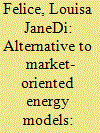

|
|
|
|
|
| Summary/Abstract |
From a biophysical perspective, energy is central to the behaviour of social-ecological systems. Its ubiquity means that energy is entangled with nexus elements, including water, land, emissions and labour. At the science-policy interface, large market-oriented energy models dominate as the tool to inform decision-making. The outputs of these models are used to shape policies, but strongly depend on sets of assumptions that are not available for deliberation and gloss over uncertainties. Taking an approach from complexity, we propose an alternative to market-oriented energy models, describing the behaviour of energy systems in relation to patterns of nexus elements across hierarchical levels. Three characteristics are central to the approach: (i) the distinction of the model's building blocks into functional and structural elements; (ii) their hierarchical organisation and (iii) the description of nexus patterns at each level, through the tool of the processor. To illustrate the model, it is applied to Catalonia's energy sector, linking production and consumption patterns. The framework may help inform stakeholder deliberation on pressing energy and nexus issues.
|
|
|
|
|
|
|
|
|
|
|
|
|
|
|
|
| 3 |
ID:
163551


|
|
|
|
|
| Summary/Abstract |
Under the Paris Agreement, countries committed to a variety of climate actions, including post-2020 greenhouse gas (GHG) emissions reduction targets. This study compares projected GHG emissions in the G20 economies under current climate policies to those under the GHG targets outlined in the nationally determined contributions (NDCs). It is based on an assessment of official governmental estimates and independent national and global studies. The study concludes that six G20 members (China, India, Indonesia, Japan, Russia and Turkey) are projected to meet their unconditional NDC targets with current policies. Eight members (Argentina, Australia, Canada, the European Union, Republic of Korea, South Africa and the United States) require further action to achieve their targets. Insufficient information is available for Saudi Arabia, and emission projections for Brazil and Mexico are subject to considerable uncertainty. The study also presents high-level decarbonisation indicators to better understand the current progress towards meeting the NDCs – Saudi Arabia and South Africa were found to continue increasing both emission intensity per unit GDP and emissions per capita under current policies by 2030 from 2015 levels.
|
|
|
|
|
|
|
|
|
|
|
|
|
|
|
|
| 4 |
ID:
163550


|
|
|
|
|
| Summary/Abstract |
Municipal solid waste in China has increased rapidly in recent years with urbanization and economic development. The establishment of affordable, effective and truly sustainable waste management is a key point for the development of urban areas. However, as a renewable energy, the cost-benefit of supporting and the environmental performance for waste incineration power are seldom discussed. This paper discusses the current situation of waste incineration power industry in China and analyzes the required subsidies and emission reductions. The results show that waste incineration power needs relatively less financial support and perform well on emission reduction. Main obstacles to the development of waste incineration have also been investigated from the perspective of government, enterprises and local residents. Lastly, some suggestions are offered on how to tackle these issues. For instance: more regulation on waste classification; to integrate the informal workers into formal municipal waste management system; to communicate more effectively to the public to dispel general misunderstanding; application of the waste heat from cogeneration plants to local heat supply or central heat supply system.
|
|
|
|
|
|
|
|
|
|
|
|
|
|
|
|
| 5 |
ID:
163547
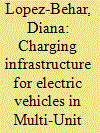

|
|
|
|
|
| Summary/Abstract |
Achieving meaningful reductions in greenhouse gas emissions from the global transportation sector will rely on a large-scale transition to electric vehicles (EVs). Many governments aim to encourage the uptake of EVs in cities, because urban areas are well suited to EV driving ranges and stand to benefit hugely from reduced local emissions. In the Canadian province of British Columbia (BC), where clean renewable electricity sourcing makes EV deployment an attractive proposition, over a quarter of residents live in Multi-Unit Residential Buildings (MURBs), most of which are not equipped with EV charging infrastructure. In a related study, Lopez-Behar et al. (accepted) explored the challenges and decision-making processes involved in the installation of EV charging infrastructure in MURBs in BC, from the perspective of different stakeholders. Here, we build on those findings to map out and analyze feedback loops within this system using a Causal Loop Diagram (CLD). We then present potential demand-focused policy interventions to address the issues raised by our modelling results, grouped into three categories: financial/fiscal, regulatory and information/awareness measures. Financial/fiscal policy measures include creating incentives for EV owners and extending them to the building owners, and programs to incentivize and provide financial aid for building owners to develop building retrofit plans. Regulatory policy measures include addressing the rights and obligations of the stakeholders and making mandatory the installation of charging stations in new MURBs. Information/awareness policy measures include expanding the existing guidelines and informing the development of a long-term EV charging infrastructure plan. Our policy recommendations are designed to inform the interventions of municipal and provincial governments in BC, but could also be relevant to many urban EV markets worldwide.
|
|
|
|
|
|
|
|
|
|
|
|
|
|
|
|
| 6 |
ID:
163553
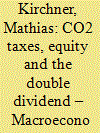

|
|
|
|
|
| Summary/Abstract |
This paper investigates the impacts of CO2 tax schemes on CO2 emissions, equity and macroeconomic indicators in Austria with the macroeconomic model DYNK[AUT]. Our scenarios focus on non-ETS CO2 emissions and comprise different tax rates and revenue recycling options (lower labor taxes, lower VAT and lump sum payments). The short-term comparative scenario analysis indicates that CO2 taxes without recycling lead to significant CO2 emission reductions at moderate economic costs. Equity impacts on households depend on the indicator used but can be regressive without recycling. Most recycling schemes can achieve a double dividend, i.e. emission reductions and increases in GDP. Lump sum payments are less efficient than reducing the VAT or labor taxes. Equity impacts are progressive with lump sum payments, rather proportional with lower VAT and regressive with lower labor taxes. A combination of recycling schemes and/or a restriction of lump sum payments to lower income households can minimize the trade-off between equity and efficiency. Our simulations suggest that well-designed CO2 tax schemes could be a crucial and socially acceptable element within a comprehensive policy package to achieve GHG emission targets for non-ETS sectors in Austria.
|
|
|
|
|
|
|
|
|
|
|
|
|
|
|
|
| 7 |
ID:
163546
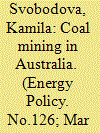

|
|
|
|
|
| Summary/Abstract |
Knowledge of mining is an important factor that can influence acceptance of activities conducted by the mining industry. However, understanding the objective knowledge of mining activities of the important stakeholder groups in mining is an issue that has been neglected. On the basis of an on-line survey focused on various target groups of stakeholders in Australia, we have examined a hypothesized model of factors that constitute knowledge of mining. The results show that knowledge of mining activities varies according to socio-demographic characteristics, experience of mining activities, and information sources about mining. Our findings highlight the key role of direct experience with mines and rehabilitation sites and the role of information in increasing knowledge of mining. In an effort to identify factors that frame acceptance of mining, the present study shows a new perspective by addressing objective knowledge of mining as an important asset that needs to be maintained and more widely spread.
|
|
|
|
|
|
|
|
|
|
|
|
|
|
|
|
| 8 |
ID:
163527


|
|
|
|
|
| Summary/Abstract |
Around 80% of domestic heat demand in Great Britain (GB) is supplied by natural gas, but continuing to heat dwellings in this way is unlikely to be compatible with national emission reduction targets. Electrical heating using heat pumps is expected to play a significant role in future space heating and hot water provision. The assessment of future heating technologies requires knowledge of the current demand for heat at short time intervals in order to evaluate peak demands and possible storage requirements. Existing half-hourly national heat demand estimates are built on data from small samples of dwellings. This paper provides estimates of GB domestic heat demand under mild, normal and cold weather conditions based on data from over 6000 dwellings collected between May 2009 and July 2010 that participated in the GB smart meter trial. The calculated peak domestic heat demand of 170 GW is around 40% lower than previously calculated suggesting that the difficulties surrounding the electrification of heat are far less profound than previously assumed. These results can be used in the development of future energy pathways and scenarios.
|
|
|
|
|
|
|
|
|
|
|
|
|
|
|
|
| 9 |
ID:
163560
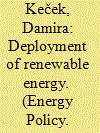

|
|
|
|
|
| Summary/Abstract |
Energy strategy of the European Union and Croatia specify the focus on generating energy from renewable sources as an important basis for achieving sustainable development. The aim of the paper is to quantify economic effects of the renewable energy sources plants deployment in Croatia. Indirect and induced effects of deploying and operating such plants have been quantified based on an input-output model. Whereas the open input-output model quantifies indirect effects, the model closed by individual consumption additionally includes induced effects related to the increase in income of the household sector. The total effects have been quantified separately for the investment channel and the channel of intermediate consumption. The results indicate that there are positive multiplicative effects related to the deployment and operation of the plants based on renewable sources in Croatia. The same amount of investments results in the highest gross value added and employment for smaller hydropower plants and biogas, whereas multiplicative effects of the wind power plants are lower due to the high share of imported equipment. The policy of fostering renewable sources will potentially have more intensive effects on the national economy if the energy and industrial strategy are better harmonised in the future.
|
|
|
|
|
|
|
|
|
|
|
|
|
|
|
|
| 10 |
ID:
163526


|
|
|
|
|
| Summary/Abstract |
Canada has numerous climatic and geographical regions and the Canadian housing stock (CHS) is diversified in terms of vintage, geometry, construction materials, envelope, occupancy, energy sources and heating, ventilation and air conditioning system and equipment. Therefore, strategies to achieve net zero energy (NZE) status with the current stock of houses need to be devised considering the unique characteristics of the housing stock, the economic conditions and energy mix available in each region. Identifying and assessing pathways for converting existing houses to NZE buildings at the housing stock level is a complex and multifaceted problem and requires extensive analysis on the impact of energy efficiency and renewable/alternative energy technology retrofits on the energy use and GHG emissions of households.
|
|
|
|
|
|
|
|
|
|
|
|
|
|
|
|
| 11 |
ID:
163535


|
|
|
|
|
| Summary/Abstract |
Thanks to new technological advancements and EU policy impulse, distributed energy resources (DER) are poised to become a viable alternative to conventional electricity generation for the provision of balancing services to transmission system operators. In this paper we show that the design variables that affect DER access to and participation in the organized balancing market include different features of auction configuration as well as a number of formal, administrative and technical aspects of market design. In a comparative case study of the balancing markets in Austria, Germany and the Netherlands, we determine the extent to which a given market design effectively facilitates DER participation. To structure this analysis, we designed an assessment framework that provides a comprehensive tool for the assessment of balancing markets in Europe vis-à-vis DER participation. Our results show that flexible pooling conditions, a higher bidding frequency and product resolution, and the authorization of non-precontracted bids, among others, can significantly ease DER integration in the market. Different design variables, however, can enhance or neutralize each other's effects, so their interrelations need to be taken into account in order to achieve an improved and harmonized balancing market design.
|
|
|
|
|
|
|
|
|
|
|
|
|
|
|
|
| 12 |
ID:
163543


|
|
|
|
|
| Summary/Abstract |
Since signing the Amsterdam Treaty in 1997, the European Union (EU) has been working on increasing its renewable energy supply. However, the progress has been uneven across member states. A vibrant literature advances several explanations for this variation, but pays insufficient attention to a critical structural factor – varying levels of natural resource wealth across the EU – and provides an incomplete account by focusing on consumption indicators. Reconciling divergent views in the literature in a single framework, we hold that while overall natural resource abundance can be conducive to renewable energy production within a country, specific natural resources, such as petroleum, are likely to be harmful. These hypotheses find empirical support in a mixed-methods study that combines a fixed-effects statistical analysis of comprehensive panel data between 1997 and 2015 with a comparative qualitative case study of the Netherlands and Belgium. The findings suggest that to achieve the ambitious goals on renewable energy deployment, the EU needs additional policies that explicitly tackle pernicious effects of specific natural resources, including rent-capturing by politicians, rent-seeking by corporate vested interests, and lack of economic incentives to diversify.
|
|
|
|
|
|
|
|
|
|
|
|
|
|
|
|
| 13 |
ID:
163533
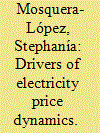

|
|
|
|
|
| Summary/Abstract |
Against the backdrop of numerous evidence that variable renewable generation decreases electricity prices and increases price volatility, this paper assesses the drivers of electricity prices in spot and futures markets, focusing on the German electricity markets. We take into account nonlinearities in electricity prices by means of structural breaks and threshold regressions. We find that short-run and medium/long-run price drivers differ and, more importantly, that they vary over time. In the case of the spot market, the determinants of prices are renewable infeed and electricity demand, while in the futures market the main drivers are natural gas, coal and carbon prices. Our results give relevant insights for market participants who seek to optimize procurement/selling strategies in the spot market, and use the futures market to hedge against spot price volatility, which has increased due to a higher renewable generation.
|
|
|
|
|
|
|
|
|
|
|
|
|
|
|
|
| 14 |
ID:
163531
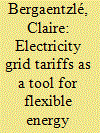

|
|
|
|
|
| Summary/Abstract |
Electricity grid tariffs are a lever for reinforcing the coupling of district heating systems to the electricity system and for activating flexibility from power-to-heat (P2H) technologies and storage capacities. This study assesses three tariffs that permit a flexible use of electric boilers in a representative district heating system in Denmark. A mixed integer programming model is developed to evaluate the impact of each tariff on district heating flexibility quantitatively. The tariffs are then discussed in the light of the regulatory requirements that network tariffs must comply with.
|
|
|
|
|
|
|
|
|
|
|
|
|
|
|
|
| 15 |
ID:
163563


|
|
|
|
|
| Summary/Abstract |
This article develops a historical perspective on Bulgarian energy dependencies and the vulnerabilities linked to these from the 1940s to today. It comprises the story of how a (post)communist country experienced and dealt with rapidly growing energy imports. The article shows how Bulgarian energy system-builders over time tested different strategies to cope with the new geopolitical conditions in the post-World War II era. It discusses the immense dilemmas that emerged and the far-reaching oscillations of the Bulgarian energy sector: between East and West, between local systems and the imports, between dependence and vulnerability, between power and security. Three main periods are discerned and analyzed. The first started in the late 1940s with the rapid communist industrialization, through which Bulgaria’s energy supply became heavily dependent on import of both resources (coal and oil in particular) and technology from the Soviet Union. The second began in early 1960s with the transition to mega-power plants fueled both by domestic lignite and uranium (enriched, however, in Soviet Union), and a gradual development of policies of energy self-sufficiency. The third one was spurred by the collapse of communism in 1989. It features the country’s accession to the EU in 2007 and the largely parallel ambition to enable a transition to renewables, both aiming the reduction of the dependence on imported energy.
|
|
|
|
|
|
|
|
|
|
|
|
|
|
|
|
| 16 |
ID:
163528
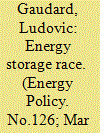

|
|
|
|
|
| Summary/Abstract |
The rise of renewable energies has brought a new challenge in terms of the management of their intermittency. Pumped-storage hydroelectricity has served as the large-scale solution to the intermittency problem. However, flawed European spot markets and innovation are jeopardizing the future of this technology. This paper: 1) estimates historic revenues of 96 energy storage installations on 17 European electricity spot markets, 2) assesses how arbitrage revenue has evolved, and 3) compares the present value of new energy technologies (compressed air, batteries) with pumped-storage in energy-only markets. Results show that market openings to competition had led to revenue drops and convergence: all markets generate low income. Based on the findings: 1) energy storage requires revenue from other markets than spot ones 2) compressed air energy storage is competitive with pumped-storage, and 3) markets value daily pumped-storage installations rather than seasonal, where this technology keeps a technical comparative advantage. It means the current best pumped-storage installation design could not be the long-term one. We also highlight that further research should investigate if interconnection, a natural monopoly, competes with energy storage, which is open to competition.
|
|
|
|
|
|
|
|
|
|
|
|
|
|
|
|
| 17 |
ID:
163567
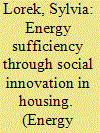

|
|
|
|
|
| Summary/Abstract |
Experience shows that energy savings through energy efficiency measures are partly compensated by income growth, and partly by rebound effects. Therefore to be effective, efficiency measures have to be embedded in a concept of sufficiency which strives for limits and absolute reduction of energy consumption. While the sufficiency concept is not new, it only recently gained attention in the field of housing. This paper provides a basis for broader and more informed debates in policy and research on the potential of sufficiency considerations to contribute to the overall reduction of energy consumption in the residential sector. It recommends shifting the attention from energy consumption of buildings towards a concept of sustainable homes in which e.g. the size of the living area plays a crucial role. A further important aspect is the possibility to fulfil other basic needs like the provision with food, recreation and social contacts in the nearby environment. The paper describes first examples of housing projects guided by sufficiency criteria, depicts the potential roles of different actor groups and points towards some general policy recommendations.
|
|
|
|
|
|
|
|
|
|
|
|
|
|
|
|
| 18 |
ID:
163566


|
|
|
|
|
| Summary/Abstract |
Pakistan, alongside other developing countries, is struggling to understand, plan and realize the energy-environment-economic nexus. In this study, we develop a national-scale bottom-up energy optimization model (Pak-TIMES) employing ANSWER-TIMES modeling framework which provides insight into this nexus for Pakistan. The reference energy system of Pak-TIMES model provides energy demand, supply, cost of energy and GHGs emissions. In total, five supply side scenarios enacted in this study are BAU (Business As Usual), RE-30 (30% renewables), RE-40 (40% renewables), Coal-30 (30% Coal) and Coal-40 (40% Coal) for the period 2015–2035. The results suggest that the cumulative investment cost incurred will be 170 billion USD to meet the electricity demand (3091 PJ) by 2035 with 181.5 million tons of GHGs emission in the BAU scenario. The most environmentally ambitious pathway, the RE-40 scenario will require 179.2 billion USD for investment with 96.0 million tons of GHGs emission. The Coal-40 scenario will cause the highest amount of GHGs emissions, i.e., 338.9 million tons with an estimated investment cost of 184.8 billion USD. Based on the results of this study, PAK-TIMES model, it is recommended that government needs to invest in renewables; given that, the environmental cost of non-renewable energy solutions is significantly higher.
|
|
|
|
|
|
|
|
|
|
|
|
|
|
|
|
| 19 |
ID:
163538
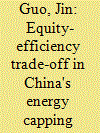

|
|
|
|
|
| Summary/Abstract |
As a part of the transition to a sustainable economy, China has set a cap on primary energy consumption for the first time, of 5.0 billion tonnes of standard coal equivalent by 2020. However, there is a debate on the cap feasibility and failure to adequately address the underlying equity-efficiency trade-off, which hampers achievement. This paper identifies some key challenges ahead, including the coal-dominant energy mix, declining financial support, inconsistent central-local goals, rising costs of energy-saving measures and quality of energy statistical data. By quantifying the preference of each providence toward equity-based or efficiency-based allocation schemes, the great disparity among provinces is revealed and the equity-efficiency trade-off relationship is confirmed. Developing regions, primarily located in central and western areas, tend to favor equity-based disaggregating schemes. Contrarily, developed coastal provinces strongly favor efficiency-based schemes. The present national disaggregation schemes are mainly based on historical energy consumption, but disregard the provincial development gap and efficiency factors. We conclude that this ambitious goal is likely within reach, but increased efforts and flexible instruments are needed.
|
|
|
|
|
|
|
|
|
|
|
|
|
|
|
|
| 20 |
ID:
163548


|
|
|
|
|
| Summary/Abstract |
Mozambique is rapidly emerging as one of the leading energy producers in Africa. We develop a comprehensive scenario analysis to review the energy revolution in Mozambique. Like much of Africa, Mozambique features a competition between development of its vast reserves of renewable energy and fossil fuels. We assess the implied energy and emissions transitions as well as the potential impact of a range of sustainable policy options. Our analysis reveals an emerging ‘energy dichotomy’, where a spectacular expansion of energy production goes together with an only gradual energy consumption transition. We find that over time the share of modern renewable energy sources tends to marginalize in the energy production mix while remaining stable in the energy consumption mix. About one-third of the GHG emissions associated with energy production can be linked to energy export. Also, we find that sustainable energy policies at the supply side lead to far higher cumulative emission reductions than demand-side policies. Finally, we show that even in the long run, a complete ban on thermal electricity generation capacity in Mozambique would by no means lead to shortages in the domestic electricity market but only slightly limit potential electricity export.
|
|
|
|
|
|
|
|
|
|
|
|
|
|
|
|
|
|
|
|
|